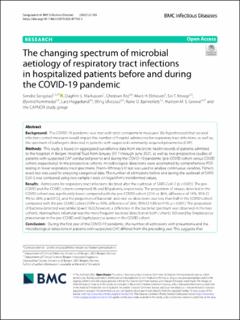| dc.description.abstract | Background: The COVID-19 pandemic was met with strict containment measures. We hypothesized that societal infection control measures would impact the number of hospital admissions for respiratory tract infections, as well as, the spectrum of pathogens detected in patients with suspected community acquired pneumonia (CAP).
Methods: This study is based on aggregated surveillance data from electronic health records of patients admitted to the hospitals in Bergen Hospital Trust from January 2017 through June 2021, as well as, two prospective studies of patients with suspected CAP conducted prior to and during the COVID-19 pandemic (pre-COVID cohort versus COVID cohort, respectively). In the prospective cohorts, microbiological detections were ascertained by comprehensive PCR-testing in lower respiratory tract specimens. Mann–Whitney’s U test was used to analyse continuous variables. Fisher’s exact test was used for analysing categorical data. The number of admissions before and during the outbreak of SARS-CoV-2 was compared using two-sample t-tests on logarithmic transformed values.
Results: Admissions for respiratory tract infections declined after the outbreak of SARS-CoV-2 (p < 0.001). The pre-COVID and the COVID cohorts comprised 96 and 80 patients, respectively. The proportion of viruses detected in the COVID cohort was significantly lower compared with the pre-COVID cohort [21% vs 36%, difference of 14%, 95% CI 4% to 26%; p = 0.012], and the proportion of bacterial- and viral co-detections was less than half in the COVID cohort compared with the pre-COVID cohort (19% vs 45%, difference of 26%, 95% CI 13% to 41%; p < 0.001). The proportion of bacteria detected was similar (p = 0.162), however, a difference in the bacterial spectrum was observed in the two cohorts. Haemophilus influenzae was the most frequent bacterial detection in both cohorts, followed by Streptococcus pneumoniae in the pre-COVID and Staphylococcus aureus in the COVID cohort.
Conclusion: During the first year of the COVID-19 pandemic, the number of admissions with pneumonia and the microbiological detections in patients with suspected CAP, differed from the preceding year. This suggests that infection control measures related to COVID-19 restrictions have an overall and specific impact on respiratory tract infections, beyond reducing the spread of SARS-CoV-2. | en_US |

